This man stuck his head into a particle accelerator. The result was remarkable.
Science

1. Particle accelerator
Pinterest
1978 was a strange year. The first so-called “test tube” baby was born. Jim Jones convinced 900 members of his parish to drink poison cool-aid. But, even more strangely, a Soviet scientist stuck his head into a particle accelerator. The results of this accidental experiment would have the scientific community reeling. Here’s what happened.
A particular accelerator, to keep it short, is a machine that works to shoot particles at extremely high speeds. The focus of the machine is to glean just what happens when physics operates on the very small scale. The mechanics of watching an apple drop, say, are far easier to grasp than watching what happens when a particle does something comparable.

Science Magazine
And this is the aim of the particle accelerator: to study what happens at one of the most diminutive levels. But what, exactly, happens when someone is hit with one of these tiniest of particles? This question is somewhat difficult to answer. This is true for several reasons. One of the most understandable is that we don’t typically use humans as our guinea pigs.
2. Ethics
The history of science is replete with mistakes. We thought leeches would cure everything, that lobotomies were a good remedy for mental illness, and that alcohol was literally inhabited by spirits. In case you didn’t know, each of these things was wrong. And it’s from these mistakes that science makes many of its ethical addendums.
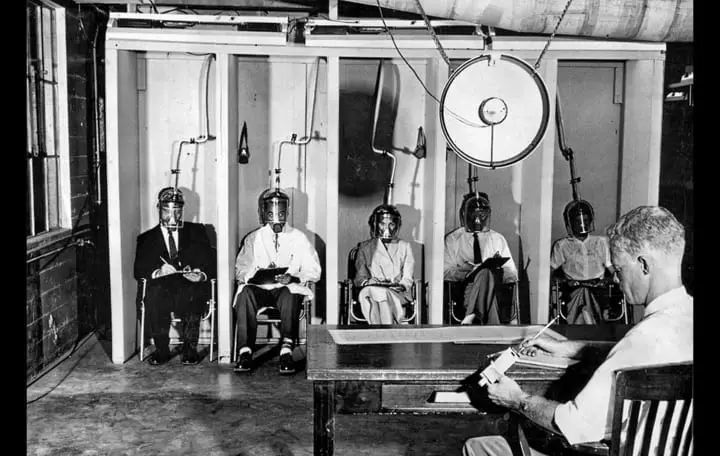
LA Times
The addendum we’re concerned about in this case is human subjects testing. We’ve learned, for instance, that humans are not the wisest initial test subjects. We should, in other words, try out our cures and remedies on animals that presumably feel less pain first—at least that’s the conclusion we’ve drawn thus far.
3. Experiment by accident
That’s why this “experiment” would never fly. While Soviet Russia has its own history of malpractice in the sciences (Lysenko’s biology, for instance, which was responsible for a massive famine all across Russia), it would likely have never approved something as egregious as shoving one’s head into a particle accelerator.

Videoblocks
This is made especially clear once you realize the damage that speedy particles can do to things much more concrete than humans. Once you see these other natural experiments, you’ll be extremely curious to know what happened to this extraordinarily hapless man. Watch out, the results may blow your mind. Seriously, prepare yourself.
4. Speedy particles
Particle accelerators send their particles at speeds soaring around 99.994 percent the speed of light. That’s roughly 670,576,392 miles per hour. In case you didn’t know, that’s pretty fast. And to get the particles to travel at such high speeds, you need some pretty hefty technology. And that’s what you’ll see below—the particle accelerator.

Pearson Electronics
Essentially, this is the purpose of different particle accelerators. You have different machines of different capacities, and these different capacities allow the particles to travel closer to the speed of light—i.e., they get us closer to the physics of the unknown. This is where things like the Higgs Boson come from.
5. When particles collide
When something of sufficient mass is traveling near the speed of light, the thing with which that massy entity comes into contact with is not going to have a good time. Normally, the result of the collision is a catastrophic explosion. Let’s go through a few examples of these so you can understand just how unfortunate this Soviet scientist was.

New Scientist
First off, we have things like asteroids that clearly make an impact. But this mostly because they are huge and formed of dense, heavy materials. When you have something enormous and heavy, you don’t need as much speed (or, as the physicists call it, energy) to do as much damage. But when you increase the speed, the mass can’t be much less to do the same amount of damage.
6. The Oh-My-God particle
Named after the reaction that many physicists had in response to recording this fast-flying spec, the Oh-My-God particle had a formidable speed. It had, in other words, something like 100 quintillion (that’s 18 zeros) times the energy that a regular photon had. That’s saying a lot.

International Space Station
For something to travel this fast, it has to be extremely small. And that is exactly why this particle didn’t cause any damage—it was so small that it didn’t actually hit anything. Had it, the magnitude of the explosion would have been something equivalent to a lazily thrown baseball. But how would such a particle interact with human flesh and bone?
7. The Synchrotron U-70
The amount of damage that a particle accelerator will do depends on a few different things. First off, it depends on just how quickly that particle is moving. The more quickly, for the most part, the more damage. The Synchrotron U-70 in Russia—the one into which this unfortunate Russian scientist stuck his head—was not the most powerful.

Russia Beyond
At the time, however, it was. What this means is that the accelerator could send the same particles at a higher energy than competing accelerators across the globe. Built in 1967, this meant that they would travel at something near to the speed of light.
8. That fateful day
On the day in question, Anatoli Petrovich Bugorski was on staff with the Institute for High Energy Physics. While on shift, however, the Synchrotron U-70 stopped working—at least that’s how things appeared. Something in the long stretch of equipment that made up the accelerator began to malfunction, and Bugorski elected to check it out.

Quartz
The machine has built within it safety mechanisms that will stop the proton beam within when someone enters inside the accelerator’s steely chambers. In this instance, however, they failed. What this means is that Bugorski would put his head into the machine while it was shooting heavy protons near the speed of light.
9. The light of a thousand suns
What Bugorski saw next was jarring. At first, he saw light—what he described as a “light brighter than a thousand suns.” This was the actual proton entering his face and exiting the other side. While we discussed already the improbability of such a small particle actually coming into contact with the atomic structure of your flesh and bone, we haven’t discussed the nature of the radiation that protons exude.

Loaded
Protons with enough energy to travel near the speed of light act like a byproduct of ample radiation. This radiation is equivalent to something you’d find in an x-ray, only magnitudes more powerful. In an x-ray, for instance, you’ll find something like a few five grays of radiation (more on “grays” later). In a particle accelerator, you’ll find two to three thousand.
10. Radiation
Now the question becomes this: what’s the result of being struck with radiation. Well, we roughly already know the answer to that. Radiation sickness, for instance, is the result of being exposed to a massive amount of radiation over a short period of time. The results of this sickness are not favorable.
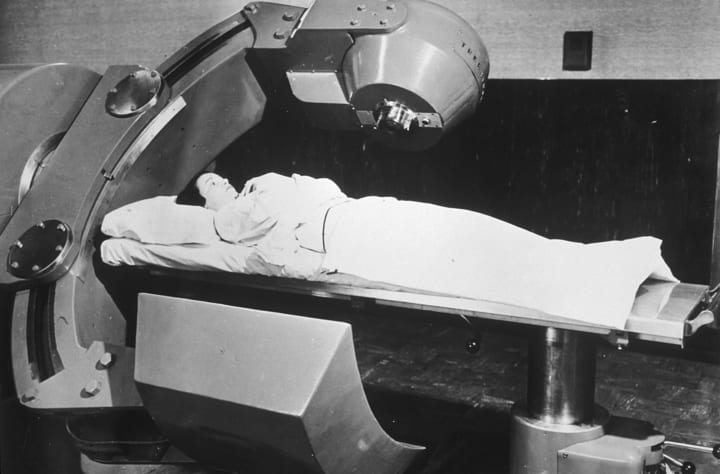
Wikiwand
Nausea, vomiting, fatigue, and burns will result after exposure to too much radiation. It is widely known, for instance, that .75 grays of exposure will likely result in death. The amount of radiation present in such an exposure is equivalent to having something like 18,000 chest x-rays. This is an amount, in case you were wondering, that is ill-advised.
11. How much radiation is too much?
To keep it short and sweet: any amount of radiation is too much. Isn’t doesn’t take more than a few mutated cells to run off and breed a handful of tumors. But too much radiation can create things far, far worse. To measure the amount of radiation given off by any radioactive thing, scientists use the term gray.

MarketWatch
In your typical x-ray, you’ll experience something like .0.00001 gray. That’s not a lot. When you get a CT scan, however, the amount of gray you’ll encounter is bit more: 0.01. A nuclear fallout, however, like those that happened in Hiroshima and Nagasaki during WWII, will give you a hefty dose of around 2 to 50. So how many does a particle accelerator expose you to? 3000.
12. Localized exposure
When a small section of the skin is subject to a blast of something like 15 to 20 gray, the skin will act in a disconcerting way. First off, you’ll experience something like a burn—swelling, redness, and itchiness will ensue. After about a week or so, the affected region will lose all of its hair.
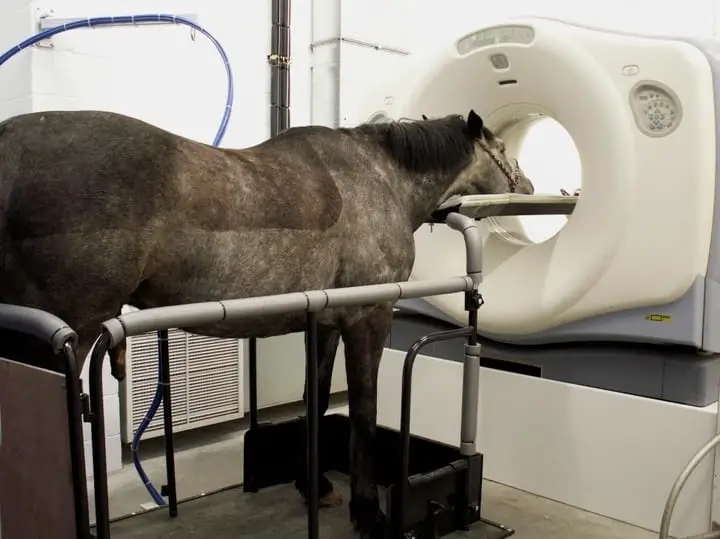
B&W Equine Group
At about the third week, the exposed area will begin to experience skin sloughing (i.e., peeling). When you experience something like 50 gray, the affected area will suffer far more far more quickly. You will, in other words, experience burning right away. And from there, blistering will occur.
13. Acute radiation syndrome
Acute radiation syndrome is the result of a full body exposure to something like 2 gray. And the results of this syndrome come in four different waves: prodrome, latent, illness, recovery. The extent to each phase is predicated on the amount of radiation you’re exposed to.

Epistem Contract Research Services
The amount of full body radiation you’d need to induce death in the half the population is around 3.5 gray. What this says about acute exposure of a drastically higher caliber is not as disconcerting as you might believe. Acute exposure, in other words, might not lead to organ failure and other ailments that usually lead to death in the case of radiation sickness.
14. The first cells to go
When one does succumb to radiation sickness, the affects are not favorable. The first thing that usually happens is that the rapidly dividing cells in the intestines and bone marrow begin to die. This is prodromal phase. Here, you’ll experience something similar to the flu—vomiting, diarrhea, fever, sweating, and fatigue. Not so pleasant, huh.

Sciencing
With a full body exposure that’s more severe—say, something like 20 to 30 gray—the person will immediately experience a lower blood pressure and “explosive diarrhea.” This undesirable constellation of discomforts eventually ends in death. But what happens if the exposure is narrowly focused yet drastically more intense?
15. From back to front
The proton beam entered from the back of Bugorski’s skull and left through his nose. The result, as one would suspect, was a lot of burning. The area in which the exposure occurred on the back of his skull lost all of its hair, for instance, and the area it exited experienced similar conditions.
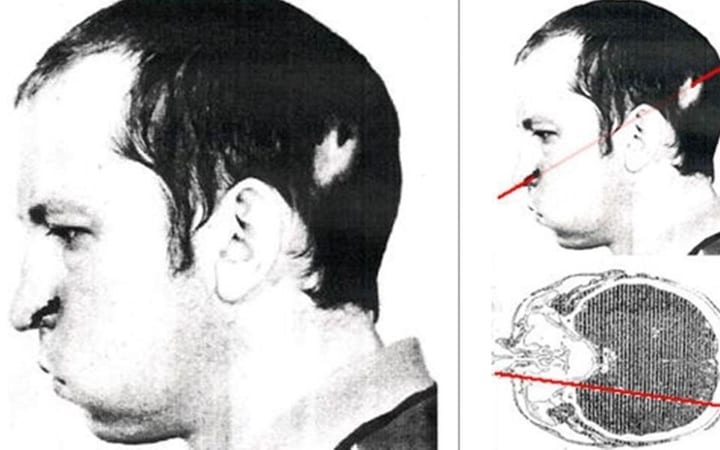
Fato Deschonhecidos
Shortly after the exposure, Bugorski’s face began to swell rapidly. This is a common thing to happen after an excessive does of radiation. In Bugorski’s case, there was so much radiation that his face was swollen beyond recognition. After which, he was taken to a nearby hospital for help.
16. A certain death?
When exposed to this much radiation, the likelihood of survival is very small. And, as such, he was not expected to live beyond the next few days. But no one, up until this point, had ever been exposed to the radiation of a proton beam. And so, the outcome of Mr. Bugowski’s life was uncertain.

Getty
Over the next few days, the skin on Bugowski’s face that met the radiation began to peel back and fall to the ground. He had, in other words, suffered extreme burning. This burning, as it turns out, extended to the inside of his skull, spreading through his cerebral tissue from his occipital lobes to the apex of his frontal lobes.
17. A life still lived
Bugorski, (both luckily and amazingly), didn’t die. Somehow, he managed to pull through. What he did experience, however, was a litany of other problems that led to, let’s just say, a depreciated quality of life. This long list includes things like partial paralysis, a loss of hearing in his left ear, and an experience of fatigue that permeated everything from exercise to thinking.
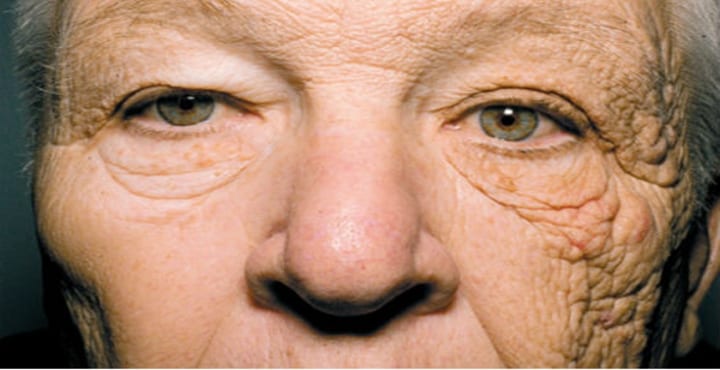
SteadyStrength
Presumably, most of this damage was due to the radiation from photon beam spreading into his cerebral tissue. It wasn’t enough damage to prevent him from pursuing and finishing his PhD, but it was enough to induce a lot of other problems. One of these was seizures.
18. A rare form of seizures
After a few years, Bugorski began to develop a rare type of seizure. This seizure, the tonic-clonic seizure, happens in less than 10 percent of the epileptic population. Normally, it unfolds as the result of hyperactivity in one localized region of the brain. This overactivity induces the seizure. Yikes.

The Dr. Oz Show
Normally, these occur on one side of the brain. And in Bugoski’s case, this part was struck by the particle beam. It makes sense, then, that the radiation emitted from this beam would damage the surrounding regions through which it passed. But other than seizures, Bugorski suffered something else: partial youth.
19. A partial paralysis
On the side of the face through which the light of a thousand suns passed, Bugorski experienced paralysis. And this side of the face, more oddly, appears more youthful. Apparently the destruction caused to the nerve and muscle fibers in that side of the face is something approximate to Botox.

The Mirror
If you’re an experimental physicist, then, and are looking for an exciting and dangerous beauty remedy, you might want to consider poking your head into the core of an operating particle accelerator. While you would suffer the radiation equivalent to 18,000 x-rays, you might also stay forever young. Some might consider the trade-off worth it. We don’t recommend this.
20. More radiation
Another common side effect of radiation is the eventual decay and death of the cells exposed. This happens generally not after initial exposure, but after weeks of having been subjected to the insult. When this does happen, it can have several adverse side effects. Among these includes burns and boils.
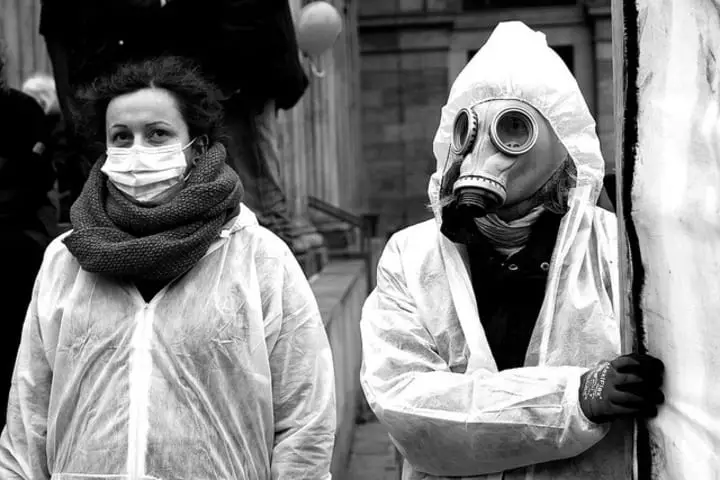
Waking Times
After a few of having been exposed to radiation, the red, swollen, and itchy areas will begin to deteriorate. The cells that compose the flesh and tissue will degenerate, leading to the development of sores and ulcers and other things unseemly. One consequence is often a breed of nuclear acne—pustules of rotten flesh residue. Gross.
21. Alpha particles
The type of radiation you’re subjected to will determine just what kind of damage you experience. There are different particles, in other words, that will ascertain the severity and caliber of aftermath that occurs in your body. Alpha particles are one of the more innocuous (albeit still terrible) forms of radiation you can experience.

Wikisource
Alpha particles are weak when they travel. And for the most part, this means that they’re easy to deflect. Something as simple as a sheet of paper, for instance, is enough to prevent them from entering and disrupting the skin. For these to do any damage, then, they really have to be ingested.
22. Beta particles
Beta particles are a little more intense on the spectrum of what you can experience with radiation. This is, for the most part, because they are extremely small. And this diminutive nature makes them much more capable of penetrating the skin. And with radiation, penetration is the problem. So layer up!

Mirion Technologies, Inc.
Still, however, clothing will protect you from these blasts. When they come into contact with skin, however, that skin will develop red splotches, itchiness, and eventual swelling. With enough time, the skin exposed to the particles could result in cell death—i.e., a healthy dose of necrosis. That’s no fun.
23. Neutrinos and gamma rays
Neutrinos and gamma rays are the most dangerous particles to encounter in the world of radiation. To prevent these from entering the skin, you must have lead protection. Since most of us don’t have this when faced with such insults, we’d likely have to suffer the result of what happens next.

AAS Nova
When you are struck by these tiny particles, they will penetrate up to a few centimeters into the skin. This will cause irritation around the entire body. With enough exposure, the result could be radiation poisoning and eventual death. The question, then, becomes this: what exact mixture of terrible particles was Bugorski subjected to?
24. Cures and remedies
There are, however, certain ways to ameliorate the damages of acute radiation poisoning. One such cure is trying to replace the affected blood. This will help replace the depleted white blood cell count, restoring the ability of the immune system to actually do its job.

NBC
Another possible remedy is the normal suite of cures: antibiotics, breathing machines, etc. When put on assisted living like this, you lower the amount of work the body has to do to perform its daily duties. And when you do that, you make it easier for the body to focus its precious resources on recovery. This is one way in which to try and assuage the massive damage done by radiation exposure.
25. Apoptosis
Apoptosis is the process of cell death. This is what happens, in essence, when the DNA of your cells is compromised: the cells will, in essence, commit suicide. This happens in a very distinct way, giving rise to the process’s name. Apo in Greek means “off,” while Ptosis means “falling.”
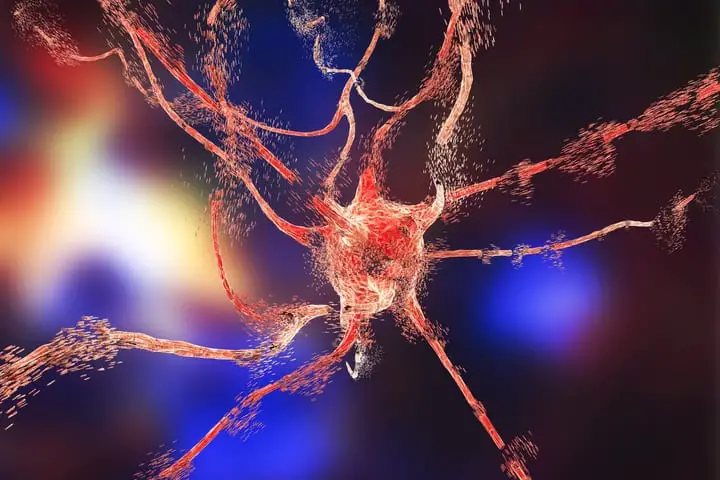
Definicion
The cells, in other words, once they have compromised DNA, fall into little pieces and then degenerate. The results of this process are that the cellular remains are recycled and used-up by the other cells in the body. If enough of this cellular decomposition occurs, however, the result is unfavorable—necrosis, cellular rot, and all those other unsavory things that result from burns and the like.
26. Proton therapy
Sometimes radiation is actually used as a way to treat cancers: not breed them. And this is this is the aim of proton therapy. In effect, a small beam of protons is shot at an acute region of the body. The purpose of this beam is to destroy, much in the ways we already discussed, the area in which the beam is aiming.

YouTube
When this area is destroyed, the cancerous cells are killed along with it. As we already mentioned, when radiation first takes hold, it often targets the most quickly replicating cells first. And since these are often the ones that are the most cancerous, the proton beam can be an effective way to kill off the cancer.
27. A bleak prognosis
Many of the doctors at the clinic expected Mr. Bugorski to die. Since he had been exposed to a dose of radiation that greatly exceeded any normal amount of exposure (not to mention that which normally kills people), his likelihood of survival was terribly low. But this turned out to be a superficial diagnosis.

Soccer Fitness Goals
Because the pathway through which the particle entered and left Bugorski’s brain was so small, the amount of total radiation he experienced was minimal. While the amount he did experience caused massive damage to the areas exposed, these areas were highly localized. And, if you remember, it took near global exposure for radiation to be completely fatal.
28. A long life
Bugorski, as of now, is still alive. It’s been several decades since the incident, and he is still going strong. He is married, in his 70s, and is entirely cancer free. If you’re going to get struck by a thin stream of radiation, then, at least try and let it be narrow and contained.

HuffPost
If not, you might suffer a less fortunate fate. This fate will be something like that described above: a launch into full-body shut down starting with severe burns. The end result will be organ failure and death from head to toes. And this is, in case you were wondering, not an outcome you would like to befall you. It would, in other words, be wise to avoid.
29. Long-time risk
Even you don’t get blasted with massive amounts of full-body radiation, moderate amounts can increase the risk of long-time exposure. And this is the problem with most of the radiation we encounter in our daily lives. This radiation increases the risk of cells mutating, inducing them to ignore the normal signals they experience with cellular replication.

The Conversation
When this happens, the cell might undergo a runaway replication spree. These replicating cells—if uncheck by other regulatory processes in the body—can turn into cancer. And this is a risk that most of should surely avoid. Bugorski, incredibly, didn’t succumb to such an ailment—likely because brain cells don’t replicate.
30. Conclusion
Ultimately, it’s not wise to stick your head into a particle accelerator. The experience—if the machine is on, that is—will expose you to a drastically high amount of radiation. While this radiation will be concentrated into a small area, the result might not be as fortuitous as Mr. Bugorski.

Pinterest
You could lose a lot more than some hair. So, to avoid this most unfateful of experiences, we’d recommend that you avoid putting your head into one. The result could be more than the normal burn or singe. And since most of us would rather avoid this, maybe you should steer clear of the particle accelerator in general.